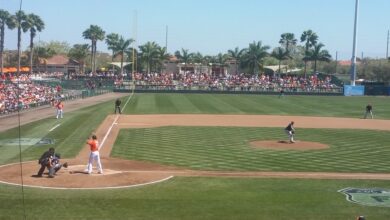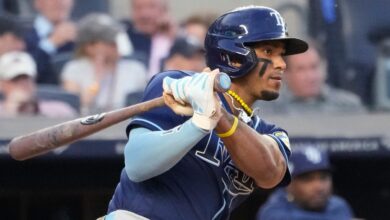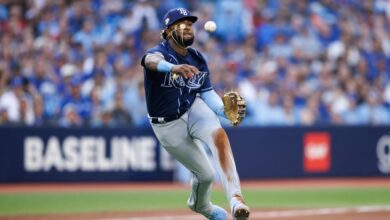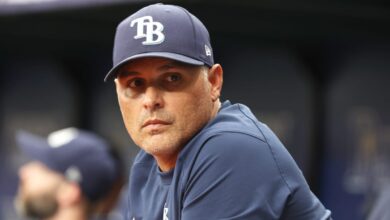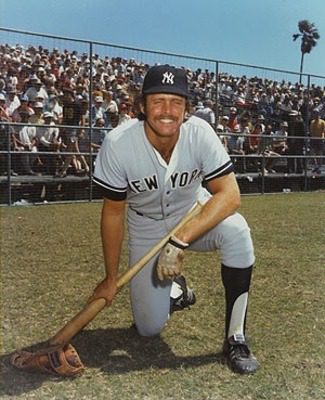
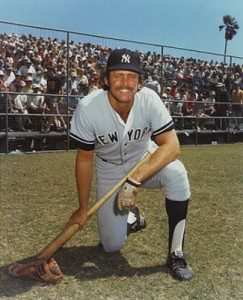
History is full of examples of how change can be a good thing. The world is a better place because of significant changes like the Emancipation Proclamation in 1863, the Declaration of Independence in 1776, and my decision in 1999 to switch to shorts full-time.
Of course, sometimes change is a bad thing. I’m sure we all could have done without the Great Depression, the Black Plague and Michael Jordan’s Hitler mustache. Change is an essential part of life, because nothing ever really stays exactly the same. And we all want the changes in our lives to be the next step toward better survival for ourselves, our friends and our families. And we all fear that our changes might just be the first step toward a life of crack cocaine and sex for cash.
Many people are afraid of change, but the folks who seem to be the most fearful of change are the old-timers over at Major League Baseball – the world’s first and only corporate office/retirement home. The league needs to expand instant replay. The technology exists. But this change will not come soon. The league needs to allow teams to trade draft picks. The other sports do this. But this change will not come soon.
And then there’s the problem with the designated hitter. Something must be done about this ridiculousness that is secretly one of the biggest problems for most of the free world. And, most likely, nothing will be done about it before it’s too late. And when is “too late”?
Next year the Houston Astros are moving to the American League, so both leagues will have the same number of teams. But, because of this, both leagues have an odd number of teams (15), meaning there will be interleague play throughout the season.
This is actually kind of a big deal and assuredly it is money motivated. Interleague games draw more interest and attendance than regular games, and so this change happened pretty quick. Though it does beg the question: Isn’t this technically the end of “interleague games,” because now they are all just “games”?
Some people don’t like any interleague games. I get it. One of the cool things about baseball was that teams for each league would only play each other in the World Series. But you know what’s cooler than that? Billions of dollars. This is also why we have an additional playoff team now. Money. And, again, I get it. I like money, too. A lot.
I enjoy interleague games a lot, and I think if the league keeps it where it’s rare for a team like the American League Red Sox to play the National League Dodgers, then we keep the spirit of the two separate leagues. What bothers me about interleague games is the designated hitter – the “DH” as the kids these days call it.
The DH is a player who bats instead of having the pitcher bat – in the American League only. Yes, baseball has two leagues and they have an almost identical set of rules by which to play, except for this teeny tiny drastically huge thing where the pitcher bats for himself in only one of the leagues.
Pitchers are traditionally very bad hitters. Of course, back in high school, the pitchers were good hitters, but that was against high-schoolers. When they are drafted as pitchers, they spend most of their time working on being better at pitching, so their abilities at the plate tend to suffer.
In the ’70s, in an attempt to raise scoring and increase their woeful attendance, the American League created the designated hitter. After a little research (I know! I don’t even know who I am anymore!) I found out that the idea for the DH has been around for almost a hundred years. So, clearly, pitchers have always been bad at hitting. And, you know what? It’s nothing to be ashamed of. Football quarterbacks aren’t as good at tackling as they are at throwing. Basketball centers aren’t as good at passing as they are at dunking. Soccer goalies aren’t as good at scoring as they are plucking their eyebrows.
Well, the AL wanted more attendance, and that’s exactly what they got as league scoring went up because teams rid themselves of their “easy out” pitchers. And fans love when teams score runs. Right, San Diego Padres fans?
The National League was not having the same attendance problems and did not follow suit. Maybe they felt this was just a temporary gimmick that would pass like so many other fads from the ’70s, like bell-bottoms, disco and un-handsome leading men in films. But it turned out the DH wasn’t temporary, and it’s one of the only things started in the ’70s that has lasted to present day – other than cocaine, of course.
For some fans, the DH is an abomination, and having the pitcher hit is the pure way to play. They also feel that making the pitcher hit allows for “more strategy” because you have to know when to pinch-hit for him or bunt or do one of those awesome double-switches where you bring in a new pitcher and fielder at the same time. I know, pretty exciting stuff. Gripping sport.
Actually, I used to like having the pitcher hit. But then I also used to like pro wrestling, G.I. Joe cartoons and Wham! (Editor’s note: “Used to,” Jed?) (Note to editor: Screw you, Jon. Maybe I do still think that “Make It Big” by Wham! is one of the best albums ever. You’re going to be sorry when I don’t wake you up before I go, go.)
Coincidentally, my distaste for the pitcher hitting started with interleague play. When an American League team is the visitor in a game, their pitcher has to hit and their DH has to play the field or sit out the games. And when a National League team is the visitor in a game, their pitcher doesn’t hit and they get a DH – except their teams don’t have these, so they just use a guy who’s just a back up, pinch-hitter type.
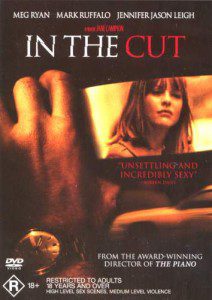
This is a ridiculous competitive advantage for the American League teams, and it really shines a light on the feebleness of pitchers at the plate. With the league switching to season-long interleague games, they need to get rid of the DH in the AL or add it to the NL. And I think they should make the DH league-wide. Look, if I wanted to watch athletes at the highest level underperforming, I’d watch women’s sports.
Come on, everyone’s been doing this player substitution thing in other sports as each has evolved – because it raises the overall quality of sport. It works in football – the best offensive players play offense and the best defensive players play defense. It wouldn’t really work in basketball because it’s non-stop motion. But, if there’s one thing that baseball isn’t, it’s non-stop motion.
In film and television, they have body doubles who substitute for actors who are too famous to appear nude – like Keira Knightly in Domino – or who have weird bodies – like Julia Roberts in Pretty Woman. We’ve all seen it happen where [a famous actress not named Kate Winslet] is about to get naked and the scene cuts to a closer shot of her, but it might not be her because the very similar looking woman in the same room now has a deep tan or larger breasts. So, you think you’re seeing the actress naked. Wahoo! But you aren’t. Awwww!
However, actresses usually wind up at a stage of their careers where showing some boob is the only way they can get their next gig because producers know they’ll sell X amount of tickets based solely on audience nudity fascination. It’s an unfortunate aspect of the entertainment industry. Maybe you were one of the unfortunate ones who saw Meg Ryan’s strange nude form in her later work or maybe you caught a glimpse of the un-round breasts of Neve Campbell.
Guys don’t really have this stage of their careers. When they get old, no one wants to see a couple wrinkly old knee bangers or a saggy derriere. Except for Michael Douglas – whose rump appears with such frequency one can only assume it’s something he insists on contractually.
So, the precedent is there in the world around us – not just in the American League. And the National League should get on board. The players union would love this. The money created for players would be significant because you pay more for a DH than you do for a PH (that’s short for a pinch-hitter – well, to me it is). If the average PH gets $1 million and the average DH gets $9 million, that’s an increase of $128 million per year spent on players. The league could get almost anything they wanted from the union in the next collective bargaining and all the fans win, too.
Another competitive disadvantage for the NL, is that AL teams get to “rest” their star players by letting them be the DH a few times a month. The player gets a little rest, but the team still gets that valuable bat in the line up. In the NL, players get the day off from fielding and they’re out of the game.
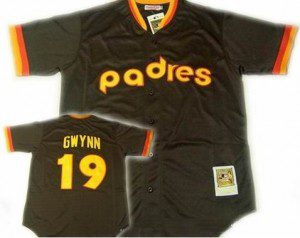
Also, free agents with a history of nagging injuries or who aren’t too defensively sound are going to favor AL teams where they can be the DH and concentrate on hitting the snot out of the ball while getting any rest they need from playing the field. Josh Hamilton is going to be one of the top free agents this coming offseason, but because of his propensity for injuries, he has to go to an American league team. The Dodgers, a National League team, will have a ton of money to spend, but they can’t spend it on him, because if he has to play the field every day, he is going to break.
And players at the end of their careers can’t stay in the National League. Do any of you remember Andre Dawson? Yikes. He spent the last few years of his career wobbling around the outfield like a senior citizen through a parking lot to the early bird special. And Hall of Famer Tony Gwynn retired from the Padres a couple years earlier than he could have had if they had a DH. And so we all missed out on a couple more years of his sweet, sweet swing and his gloriously rotund belly.
My point is that, at the highest level of competition, we want to see the highest level of competition. And both leagues should have the ability to play at the same level. Because, you know, they’re playing the same sport. Against each other.
However, hope is not lost. Major League Baseball can make changes that aren’t based solely on increased revenues. They have shown they can with integration, with free agency and more recently with drug testing.
Rocky Balboa said it best after his unlikely defeat of Ivan “the Siberian Express” Drago: “If I can change, and you can change, everybody can change!” True words – written clumsily, spoken awkwardly – from a stupid movie, but true nonetheless.



